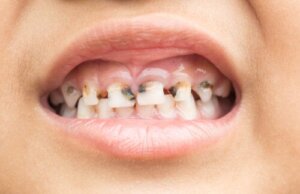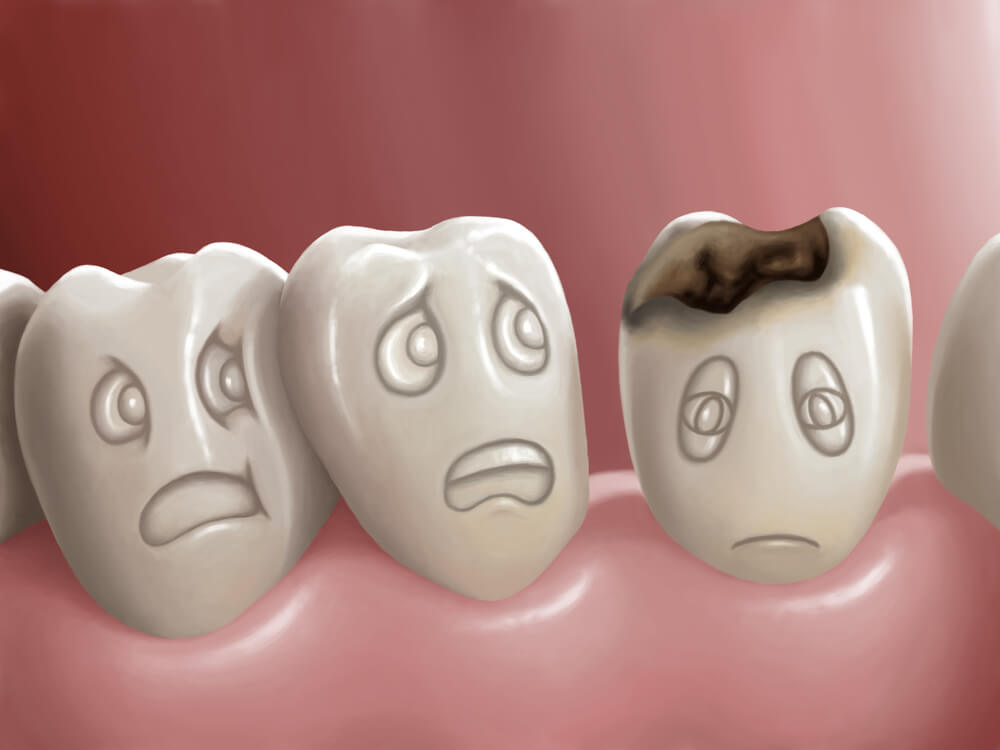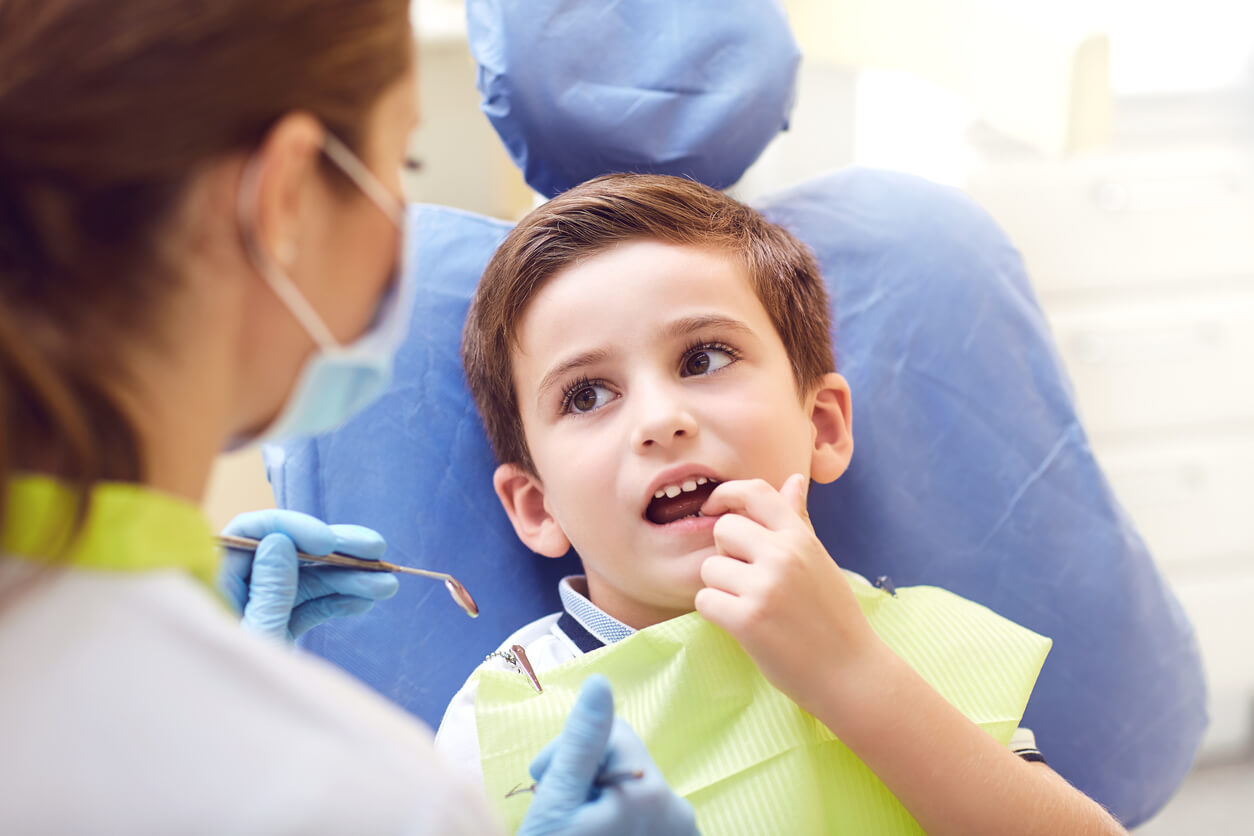Is It Necessary to Treat Cavities in Baby Teeth?

Many parents think that it’s not necessary to treat cavities in baby teeth, as these teeth are going to fall out sooner or later. But this belief is not only wrong but also quite dangerous.
Cavities are one of the most prevalent diseases worldwide and their appearance during childhood is quite common. In fact, according to the Global Burden of Disease Study conducted in 2017, more than 530 million infants in the world have cavities in their baby teeth.
Suffering from cavities during childhood influences the child’s well-being and daily life: it affects the appearance of their smile, makes them uncomfortable when eating or speaking, and causes pain. In addition, it increases the risk of suffering from dental infections and losing baby teeth ahead of time.
Therefore, it’s absolutely necessary to treat cavities in baby teeth in order to preserve the health of the little ones. We’ll tell you more about it in the article below.
Why do we have to treat cavities in baby teeth?
To understand the need to treat cavities in baby teeth, it’s crucial to understand the negative effects that this disease brings.
Interference with oral functions
The carious process destroys the integrity of the hard tissues of the teeth. Stained, broken, and even destroyed dental elements affect the normal functioning of the mouth. And although it’s true that baby teeth are transitory, their presence is vital for the correct development of children.
Below, we’ll mention the most important functions of temporary teeth:
- They favor feeding: Primary dentition allows children to learn to chew and swallow properly.
- They participate in the development of speech. Many phonemes require these elements in order to be pronounced correctly, and this is a fundamental aspect of learning.
- They guide the eruption of the permanent teeth: Baby teeth reserve the necessary space for permanent teeth to be located later. If baby teeth are broken or lost prematurely, this guiding process can be altered and cause dental malpositions or bite problems.
- They promote the development of the jaws: The presence and use of temporary elements allow the jaws to grow and develop as expected.
- They maintain the aesthetics of the mouth: Preserving the healthy appearance of a child’s teeth strengthens their self-esteem. When their teeth are diseased, little ones can feel ashamed of themselves and be teased.

Uncomfortable symptoms
Cavities cause the loss of the hard tissues of the tooth, due to the action of the acids produced by the bacteria in the mouth. This phenomenon is related to a high intake of carbohydrates and inadequate oral hygiene. Although some individual factors and the time of evolution of these issues also play a role.
At the beginning of this disease, the teeth are stained with a characteristic dull white color. Then, as the process progresses, these spots appear yellow, brown, or black.
If the disease remains untreated, the teeth are destroyed, and gaps and holes appear on their surface. This can affect the dental pulp, which is the innermost part of the dental elements. Consequently, sensitivity and pain increase.
Having teeth with cavities affects the appearance of children’s smiles and also retains the bacterial plaque that causes bad breath and predisposes them to suffer from other oral diseases.
In turn, tooth pain from cavities interferes with the functions of the mouth and causes a lot of discomfort in the child. This alters the daily life of the child and their family, as the painful sensation at night affects everyone’s rest. Finally, sleeping poorly translates into decreased school performance and an increase in absenteeism.
Children’s health complications
The infectious origin of cavities predisposes children to suffer other inconveniences in the mouth and also affects the body’s ability to rest.
The appearance of fistulas with pus in the gums, the swelling of the face, the inflammation of the maxillary nodes, and even the rise of fever can indicate the complication of cavities with a dental abscess. In these cases, it’s pertinent to go to the dentist urgently.
Another important point is that the bacteria that cause cavities in baby teeth can affect the final pieces that are forming below. This can result in stains, changes in the enamel, hypoplasia, and other structural damage to the permanent elements.
The most severe cases can give rise to infections in other parts of the body, such as the heart valves or even sepsis.
Finally, another complication associated with this disease involves delays in growth and in the physical development of the child.
How to treat cavities in baby teeth?
To treat cavities in milk teeth, it’s important to go to see a pediatric dentist regularly, as they’re the most suitable professional to solve this problem.
After a thorough evaluation of the state of health of the child’s mouth, the dentist will choose the appropriate therapy for each case. It may include the following treatments:
- Stopping the process: In the case of incipient cavities, the use of local fluoride can stop the lesion and help restore dental health. Habit changes at this stage will also be necessary.
- Fillings: If the lesions are more advanced, but without pulp involvement, the area can be cleaned and then filled with a filling.
- Pulp treatments: When the pulp is compromised, treatments that clean this area and then restore the dental anatomy will be necessary.
- Medication: If there’s an infection, abscess, or facial cellulitis of dental origin, it will be necessary to resort to antibiotics.
- Extraction: The most severe cases may require the extraction of the dental element in order to preserve the health of the permanent tooth that forms below. In these cases, a device must be placed to maintain the space until the moment of the eruption of the definitive piece.
- Counseling: Whatever the therapy of choice, the pediatric dentist is in charge of advising the parents regarding pertinent oral care at home.

The importance of prevention
As we mentioned, when cavities appear in milk teeth, it’s very important to treat them. But the ideal situation is to prevent them from developing in the first place and this can be achieved with simple measures at home.
Taking care of maintaining adequate oral hygiene is essential in order to eliminate the bacterial plaque that causes cavities. Frequent and well-performed tooth brushing, flossing, and fluoride toothpaste help clean teeth, gums, and tongue properly.
Paying special attention to feeding children is also necessary. In this sense, care must be taken to assure that their diet isn’t rich in simple sugars, acids, or carbonated drinks.
Visiting the dentist every 6 months from the first year of life is another way to take care of the child’s oral health and avoid cavities. Periodic check-ups make it possible to detect any problem in time, discover risk factors, and optimize the oral care of children.
Avoiding cavities in milk teeth and treating them in a timely manner is the responsibility of adults. With proper care, your little one will be able to smile freely.
Many parents think that it’s not necessary to treat cavities in baby teeth, as these teeth are going to fall out sooner or later. But this belief is not only wrong but also quite dangerous.
Cavities are one of the most prevalent diseases worldwide and their appearance during childhood is quite common. In fact, according to the Global Burden of Disease Study conducted in 2017, more than 530 million infants in the world have cavities in their baby teeth.
Suffering from cavities during childhood influences the child’s well-being and daily life: it affects the appearance of their smile, makes them uncomfortable when eating or speaking, and causes pain. In addition, it increases the risk of suffering from dental infections and losing baby teeth ahead of time.
Therefore, it’s absolutely necessary to treat cavities in baby teeth in order to preserve the health of the little ones. We’ll tell you more about it in the article below.
Why do we have to treat cavities in baby teeth?
To understand the need to treat cavities in baby teeth, it’s crucial to understand the negative effects that this disease brings.
Interference with oral functions
The carious process destroys the integrity of the hard tissues of the teeth. Stained, broken, and even destroyed dental elements affect the normal functioning of the mouth. And although it’s true that baby teeth are transitory, their presence is vital for the correct development of children.
Below, we’ll mention the most important functions of temporary teeth:
- They favor feeding: Primary dentition allows children to learn to chew and swallow properly.
- They participate in the development of speech. Many phonemes require these elements in order to be pronounced correctly, and this is a fundamental aspect of learning.
- They guide the eruption of the permanent teeth: Baby teeth reserve the necessary space for permanent teeth to be located later. If baby teeth are broken or lost prematurely, this guiding process can be altered and cause dental malpositions or bite problems.
- They promote the development of the jaws: The presence and use of temporary elements allow the jaws to grow and develop as expected.
- They maintain the aesthetics of the mouth: Preserving the healthy appearance of a child’s teeth strengthens their self-esteem. When their teeth are diseased, little ones can feel ashamed of themselves and be teased.

Uncomfortable symptoms
Cavities cause the loss of the hard tissues of the tooth, due to the action of the acids produced by the bacteria in the mouth. This phenomenon is related to a high intake of carbohydrates and inadequate oral hygiene. Although some individual factors and the time of evolution of these issues also play a role.
At the beginning of this disease, the teeth are stained with a characteristic dull white color. Then, as the process progresses, these spots appear yellow, brown, or black.
If the disease remains untreated, the teeth are destroyed, and gaps and holes appear on their surface. This can affect the dental pulp, which is the innermost part of the dental elements. Consequently, sensitivity and pain increase.
Having teeth with cavities affects the appearance of children’s smiles and also retains the bacterial plaque that causes bad breath and predisposes them to suffer from other oral diseases.
In turn, tooth pain from cavities interferes with the functions of the mouth and causes a lot of discomfort in the child. This alters the daily life of the child and their family, as the painful sensation at night affects everyone’s rest. Finally, sleeping poorly translates into decreased school performance and an increase in absenteeism.
Children’s health complications
The infectious origin of cavities predisposes children to suffer other inconveniences in the mouth and also affects the body’s ability to rest.
The appearance of fistulas with pus in the gums, the swelling of the face, the inflammation of the maxillary nodes, and even the rise of fever can indicate the complication of cavities with a dental abscess. In these cases, it’s pertinent to go to the dentist urgently.
Another important point is that the bacteria that cause cavities in baby teeth can affect the final pieces that are forming below. This can result in stains, changes in the enamel, hypoplasia, and other structural damage to the permanent elements.
The most severe cases can give rise to infections in other parts of the body, such as the heart valves or even sepsis.
Finally, another complication associated with this disease involves delays in growth and in the physical development of the child.
How to treat cavities in baby teeth?
To treat cavities in milk teeth, it’s important to go to see a pediatric dentist regularly, as they’re the most suitable professional to solve this problem.
After a thorough evaluation of the state of health of the child’s mouth, the dentist will choose the appropriate therapy for each case. It may include the following treatments:
- Stopping the process: In the case of incipient cavities, the use of local fluoride can stop the lesion and help restore dental health. Habit changes at this stage will also be necessary.
- Fillings: If the lesions are more advanced, but without pulp involvement, the area can be cleaned and then filled with a filling.
- Pulp treatments: When the pulp is compromised, treatments that clean this area and then restore the dental anatomy will be necessary.
- Medication: If there’s an infection, abscess, or facial cellulitis of dental origin, it will be necessary to resort to antibiotics.
- Extraction: The most severe cases may require the extraction of the dental element in order to preserve the health of the permanent tooth that forms below. In these cases, a device must be placed to maintain the space until the moment of the eruption of the definitive piece.
- Counseling: Whatever the therapy of choice, the pediatric dentist is in charge of advising the parents regarding pertinent oral care at home.

The importance of prevention
As we mentioned, when cavities appear in milk teeth, it’s very important to treat them. But the ideal situation is to prevent them from developing in the first place and this can be achieved with simple measures at home.
Taking care of maintaining adequate oral hygiene is essential in order to eliminate the bacterial plaque that causes cavities. Frequent and well-performed tooth brushing, flossing, and fluoride toothpaste help clean teeth, gums, and tongue properly.
Paying special attention to feeding children is also necessary. In this sense, care must be taken to assure that their diet isn’t rich in simple sugars, acids, or carbonated drinks.
Visiting the dentist every 6 months from the first year of life is another way to take care of the child’s oral health and avoid cavities. Periodic check-ups make it possible to detect any problem in time, discover risk factors, and optimize the oral care of children.
Avoiding cavities in milk teeth and treating them in a timely manner is the responsibility of adults. With proper care, your little one will be able to smile freely.
All cited sources were thoroughly reviewed by our team to ensure their quality, reliability, currency, and validity. The bibliography of this article was considered reliable and of academic or scientific accuracy.
- James, S. L., Abate, D., Abate, K. H., et al. (2018). Global, regional, and national incidence, prevalence, and years lived with disability for 354 diseases and injuries for 195 countries and territories, 1990–2017: a systematic analysis for the Global Burden of Disease Study 2017. The Lancet, 392(10159), 1789-1858.
- Organización Mundial de la Salud. (2021). Poner fin a la caries dental en la infancia: manual de aplicación de la OMS. Organización Mundial de la Salud. https://apps.who.int/iris/handle/10665/340445. Licencia: CC BY-NC-SA 3.0 IGO
- Khanh, L. N., Ivey, S. L., Sokal-Gutierrez, K., et al. (2015). Early childhood caries, mouth pain, and nutritional threats in Vietnam. American journal of public health, 105(12), 2510-2517.
- Illescas, P. L. A., León, K. C., León, E. V., & Coral, B. V. (2021). Estado nutricional y caries de infancia temprana en niños de 0 a 3 años: Revisión de la literatura. Revista Odontología Pediátrica, 20(1), 49-59.
- Sánchez-Pérez, L., Sáenz Martínez, L. P., Molina-Frechero, N., Irigoyen-Camacho, M. E., & Alfaro-Moctezuma, P. (2018). Riesgo a caries. Diagnóstico y sugerencias de tratamiento. Revista ADM, 75(6).
- Frencken, J. O. (2018). Tratamiento restaurador atraumático. Revista de la Facultad de Odontología, 12(2).
- Minaya Ramos, G. G. (2021). Factores de riesgo de caries en dentición primaria (Bachelor’s thesis, Universidad de Guayaquil. Facultad Piloto de Odontología).
- Zambrano Hidalgo, M. J. (2021). Caries de la infancia temprana: prevención y tratamientos: Revisión sistemática.
This text is provided for informational purposes only and does not replace consultation with a professional. If in doubt, consult your specialist.








